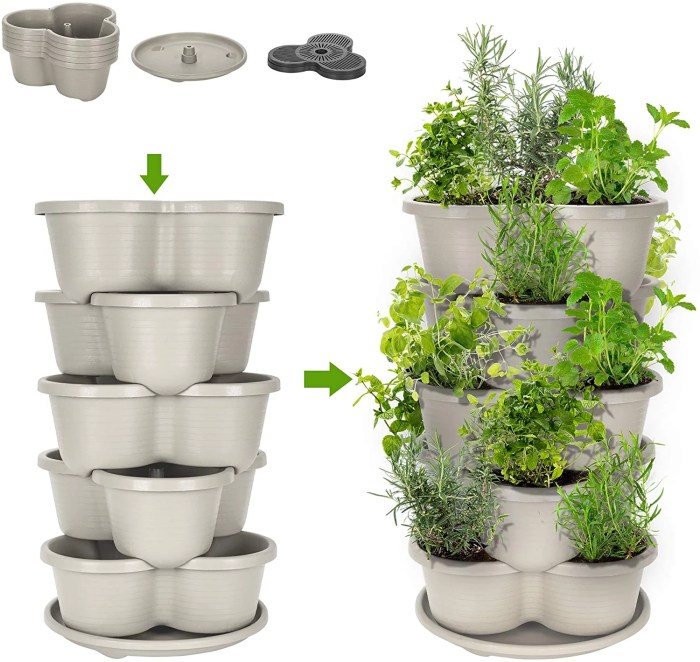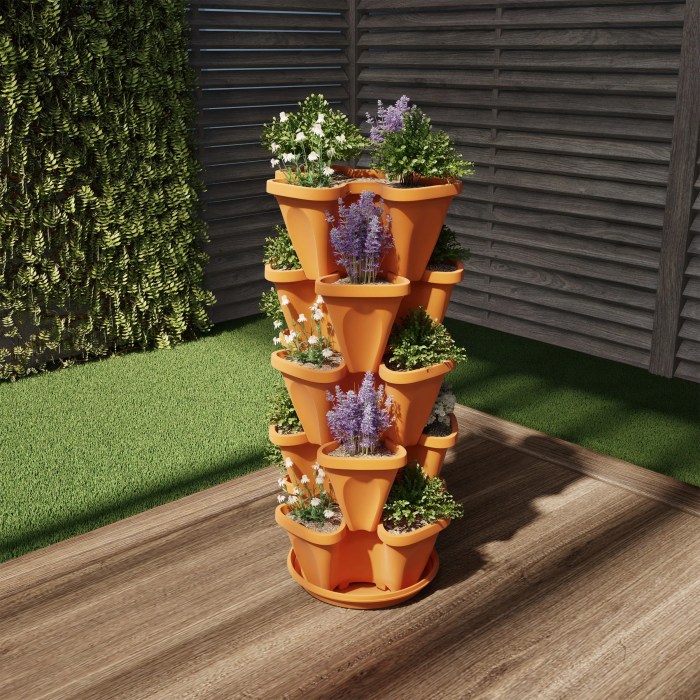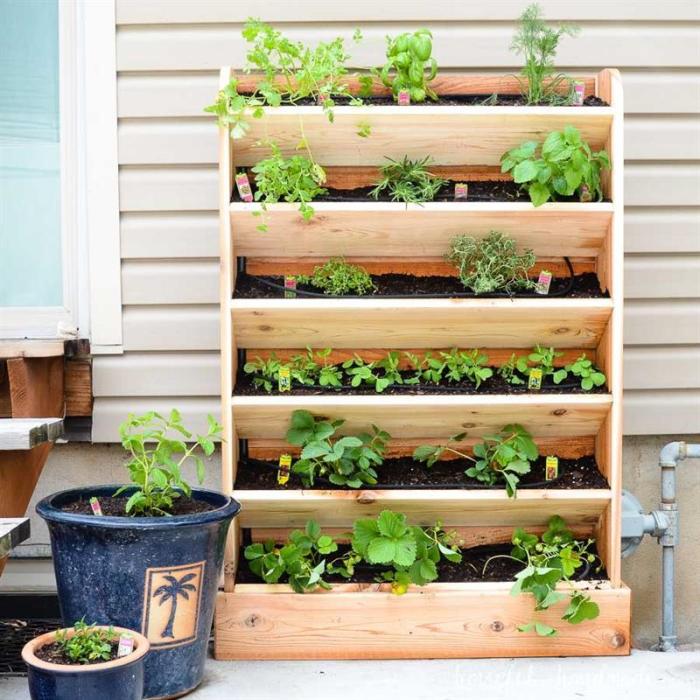Vertical herb gardens are a brilliant solution for urban dwellers and gardening enthusiasts alike, offering a convenient and space-saving way to cultivate fresh herbs at home. These gardens not only add a touch of greenery and freshness to your living space but also provide a readily available source of flavorful ingredients for your culinary creations.
Whether you’re a seasoned gardener or just starting your green-thumbed journey, this guide will provide you with all the essential knowledge and practical tips you need to create and maintain a thriving vertical herb garden.
Vertical Herb Garden Overview
A vertical herb garden is a gardening technique that involves growing herbs vertically, often on a wall or trellis, rather than in traditional horizontal rows. This approach offers several advantages, including space optimization, improved air circulation, and enhanced aesthetics.
Vertical herb gardens are particularly beneficial for small spaces, such as balconies, patios, or narrow urban gardens. They allow gardeners to maximize vertical space and grow a wide variety of herbs in a limited area.
Different Vertical Herb Garden Designs
There are numerous vertical herb garden designs to choose from, each with its own advantages and aesthetics. Some popular designs include:
- Hanging planters:Herbs can be grown in individual hanging planters suspended from a wall or ceiling.
- Vertical wall planters:These are self-contained planters that are mounted directly to a wall and can hold multiple herbs in individual compartments.
- Trellises:Herbs can be trained to climb trellises, creating a vertical wall of greenery.
- Stacked planters:Herbs can be grown in stacked planters, with each planter placed on top of the other, creating a tiered effect.
- DIY vertical gardens:Creative gardeners can also construct their own vertical herb gardens using repurposed materials, such as pallets, old ladders, or wooden crates.
Planning and Designing a Vertical Herb Garden
To create a thriving vertical herb garden, careful planning and design are essential. Here are some key considerations:
Determining the Best Location
- Sunlight:Most herbs require at least 6 hours of sunlight per day. Choose a location that receives ample sunlight throughout the growing season.
- Water Access:Ensure the vertical garden is easily accessible for watering, as herbs need regular hydration.
- Wind Protection:Strong winds can damage delicate herb plants. Select a location that is sheltered from prevailing winds.
Selecting the Right Herbs
Not all herbs are suitable for vertical gardening. Choose herbs that:
- Compact Growth Habit:Herbs with a compact or trailing growth habit are ideal for vertical gardens.
- Shallow Root System:Herbs with shallow root systems can thrive in the limited soil depth of vertical planters.
- Heat Tolerance:If the vertical garden will be exposed to direct sunlight, select heat-tolerant herbs.
Designing the Layout
The layout of the vertical herb garden should be functional and visually appealing:
- Grouping Herbs:Group herbs with similar water and sunlight requirements together.
- Vertical Stacking:Stack herbs vertically to maximize space utilization.
- Aesthetic Appeal:Consider the visual impact of the vertical herb garden and arrange the herbs in a pleasing manner.
Building a Vertical Herb Garden
Constructing a vertical herb garden is an enjoyable and rewarding endeavor that offers numerous advantages. It is an excellent option for small spaces, as it maximizes vertical space, and it allows you to grow a wide variety of herbs conveniently.
Building a vertical herb garden is not a complex task, and it can be customized to suit your specific needs and preferences. Here are step-by-step instructions for building a vertical herb garden using different materials:
Using Wood
- Materials:
- Wooden pallets or new lumber
- Wood screws or nails
- Drill or hammer
- Saw (if using new lumber)
- Optional: Stain or paint for finishing
Steps:
- Cut the wood to the desired size and shape.
- Assemble the wooden frame by attaching the side panels to the top and bottom panels using screws or nails.
- Attach the crossbars to the frame to create shelves for the plants.
- Optional: Stain or paint the vertical herb garden for added protection and aesthetics.
- Fill the shelves with soil and plant your herbs.
Using Pallets
- Materials:
- Wooden pallets
- Wood screws or nails
- Drill or hammer
- Optional: Stain or paint for finishing
Steps:
- Disassemble the pallets to separate the individual boards.
- Reassemble the boards into a vertical structure, attaching them together with screws or nails.
- Optional: Stain or paint the vertical herb garden for added protection and aesthetics.
- Fill the spaces between the boards with soil and plant your herbs.
Using PVC Pipes
- Materials:
- PVC pipes (4-6 inches in diameter)
- PVC pipe cutter
- PVC glue
- End caps for PVC pipes
- Drill
- Screws or nails
Steps:
- Cut the PVC pipes to the desired length.
- Glue the end caps onto one end of each pipe.
- Drill holes into the sides of the pipes for drainage.
- Attach the pipes to a vertical support (e.g., a wall or fence) using screws or nails.
- Fill the pipes with soil and plant your herbs.
Planting and Care for Vertical Herb Gardens

Vertical herb gardens offer a convenient and space-saving way to grow herbs indoors or outdoors. To ensure healthy and thriving plants, proper planting and care techniques are essential.
Planting Techniques
When planting herbs in a vertical garden, it’s important to choose plants that are suitable for the growing conditions and space available. Herbs that thrive in vertical gardens include basil, mint, parsley, chives, and rosemary. Select healthy seedlings or cuttings and carefully plant them in the designated holes or pockets.
Ensure the roots are well-spread and the soil is firmly packed around them.
Watering and Fertilizing
Watering frequency for vertical herb gardens depends on the type of herbs grown, the climate, and the size of the garden. As a general rule, water when the soil feels dry to the touch. Use lukewarm water and avoid overwatering, as it can lead to root rot.Fertilize vertical herb gardens every few weeks during the growing season.
Use a balanced, water-soluble fertilizer diluted according to the manufacturer’s instructions. Avoid over-fertilizing, as it can burn the plants.
Maintenance and Troubleshooting
Regular maintenance is crucial for the health of vertical herb gardens. This includes pruning to encourage bushy growth, removing dead or diseased leaves, and keeping the garden free of weeds.Common pests that may affect vertical herb gardens include aphids, spider mites, and whiteflies.
Treat infestations promptly using insecticidal soap or neem oil. Diseases such as powdery mildew and botrytis can also occur, particularly in humid conditions. Improve air circulation and avoid overwatering to prevent these issues.
Harvesting and Using Herbs from Vertical Gardens
Harvesting herbs from vertical gardens is easy and rewarding. To ensure the best flavor and quality, harvest herbs in the morning after the dew has dried. Use sharp scissors or a knife to cut stems just above a leaf node.
This will encourage new growth and keep your herbs healthy.Fresh herbs from vertical gardens can be used in a variety of ways. Add them to salads, soups, stews, and other dishes for a burst of flavor. You can also use them to make homemade sauces, dressings, and marinades.Here are a few recipes and ideas for incorporating herbs into dishes:
Herb-infused olive oil
Combine fresh herbs with olive oil in a jar and let it infuse for a few weeks. Use this oil for salad dressings, marinades, or dipping bread.
Herb butter
Mix fresh herbs with softened butter and spread it on bread, crackers, or vegetables.
Herb salt
Combine fresh herbs with salt and grind them together. Use this herb salt to season meats, vegetables, or pasta dishes.
Herb tea
Steep fresh herbs in hot water for a refreshing and flavorful tea.
Troubleshooting Vertical Herb Gardens

Vertical herb gardens, like any gardening endeavor, can occasionally encounter challenges. Understanding and resolving these issues is crucial for maintaining healthy and thriving herbs. Common problems include poor growth, pests, diseases, and structural damage.
Identifying and Resolving Common Problems
Poor Growth
Causes
Insufficient sunlight, nutrient deficiency, overwatering/underwatering, extreme temperatures
Solutions
Ensure adequate sunlight, fertilize regularly, adjust watering schedule, provide temperature protection Pests
Common pests
Aphids, spider mites, whiteflies
Solutions
Use insecticidal soap, neem oil, or companion planting to deter pests Diseases
Common diseases
Powdery mildew, botrytis, root rot
Solutions
Improve air circulation, use disease-resistant varieties, treat with fungicides if necessary Structural Damage
Causes
Strong winds, improper support, overloaded shelves
Solutions
Secure the structure, provide additional support, distribute weight evenly across shelves
Tips for Troubleshooting
- Regularly inspect your vertical herb garden for any signs of problems.
- Research specific issues to determine the most effective solutions.
- Consider using companion planting to deter pests and improve growth.
- Seek advice from gardening experts or online resources if needed.
- Be patient and persistent in resolving issues; healthy herbs will eventually thrive.
Advanced Techniques for Vertical Herb Gardens

Vertical herb gardens offer a unique way to grow herbs in small spaces. By using advanced techniques, you can maximize yield and efficiency in your vertical herb garden.
In this article, we will discuss trellising, hydroponics, and automated watering systems. We will also provide examples of innovative vertical herb garden designs.
Trellising
Trellising is a technique used to support climbing plants. In a vertical herb garden, trellising can be used to support tall or vining herbs, such as tomatoes, cucumbers, and beans. Trellising can also be used to create a more organized and attractive garden.There are a variety of different trellising materials available, including wood, metal, and plastic.
The type of material you choose will depend on the size and weight of your plants.
Hydroponics
Hydroponics is a method of growing plants in a nutrient-rich water solution. Hydroponic systems can be used to grow herbs in vertical gardens, as they provide a controlled environment that is ideal for plant growth.There are a variety of different hydroponic systems available, including deep water culture, nutrient film technique, and aeroponics.
The type of system you choose will depend on the size and type of herbs you are growing.
Automated Watering Systems
Automated watering systems can be used to water your vertical herb garden on a regular basis. This can save you time and ensure that your plants are getting the water they need.There are a variety of different automated watering systems available, including drip irrigation, subirrigation, and misting systems.
The type of system you choose will depend on the size and type of herbs you are growing.
Epilogue

Incorporating a vertical herb garden into your home is a rewarding experience that brings both aesthetic and culinary benefits. With proper planning, care, and a touch of creativity, you can enjoy a continuous supply of fresh, aromatic herbs to enhance your meals and elevate your culinary creations.
So, let’s dive into the world of vertical herb gardens and discover the joy of growing your own herbs in a sustainable and space-efficient way.